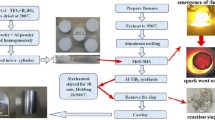Abstract
In-situ TiB2/7055Al nanocomposites are fabricated by in situ melt chemical reaction from 7055Al-K2TiF6-KBF4 system under high intensity ultrasonic field, and the mechanism and kinetic model of insitu melt chemical reaction are investigated. X-ray diffraction (XRD) and scanning electron microscope (SEM) analyses indicate that the sizes of in-situ TiB2 nanoparticles are in the range of 80–120 nm. The results of icewater quenched samples show that the whole process contains four stages, and the overall in-situ reaction time is 10 minutes. The in situ synthesis process is controlled mainly by chemical reaction in earlier stage (former 3 minutes), and by the particulate diffusing in later stage. The mechanism of key reaction between Al3Ti and AlB2 under high intensity ultrasonic in the 7055Al-K2TiF6-KBF4 system is the reaction-diffusion-crack-rediffusion. Furthermore, the reactive kinetic models in 7055Al-K2TiF6-KBF4 system are established.
Similar content being viewed by others
References
X G Fan, D M Jiang, Q C Meng, et al. The Micro Structural Evolution of An Al-Zn-Mg-Cu Alloy during Homogenization[J]. Materials Letters, 2006, 60(12):1 475–1 479
K Shen, Z M Yin, T Wang. On Spinodal Decomposition in Ageing 7055 Aluminum Alloys[J]. Materials Science and Engineering: A, 2008, 477(1–2): 395–398
L J Zheng, C Q Chen, T T Zhou, et al. Structure and Properties of Ultrafine-grained Al-Zn-Mg-Cu and Al-Cu-Mg-Mn Alloys Fabricated by ECA Pressing Combined with Thermal Treatment[J]. Materials Characterization, 2003, 49(5): 455–461
Y X Jin, J G Li, J M Lee, et al. Dry Sliding Friction and Wear Properties and Wear Mechanism of SiCP/Al Composites[J]. Journal of Wuhan University of Technolotgy, 2009, 24: 24–28
W H Yuan, J Zhang, C C Zhang, et al. Processing of Ultrahigh Strength SiCp/Al-Zn-Mg-Cu Composites[J]. Journal of Materials Processing Technology, 2009, 209(7): 3 251–3 255
F Ji, M Z Ma, A J Song, et al. Creep Behavior of In situ TiCP/2618 Aluminum Matrix Composite[J]. Materials Science and Engineering: A, 2009, 506(1–2): 58–62
K Das, L K Narnaware. A Study of Microstructure and Tribological Behaviour of Al-4.5% Cu/Al3Ti Composites[J]. Materials Characterization, 2009, 60(8): 808–811
A Ramirez, M Qian, B Davis. Potency of High-intensity Ultrasonic Treatment for Grain Refinement of Magnesium Alloys[J]. Scripta Materialia, 2008, 59(1): 19–22
M S Jensen, M Pezzotta, Z L Zhang. Degradation of TiB2 Ceramics in Liquid Aluminum[J]. Journal of the European Ceramic Society, 2008, 28(16): 3 155–3 164
K Sivaprasad, S P Kumaresh Babu, S Natarajan. Study on Abrasive and Erosive Wear Behavior of Al 6063/TiB2 In situ Composites [J]. Materials Science and Engineering: A, 2008, 498(1–2): 495–500
A Mandal, M Chakraborty, B S Murty. Effect of TiB2 Particles on Sliding Wear Behavior of Al-4Cu Alloy[J]. Wear, 2007, 262(1–2): 160–166
N El-Mahallawy, M A Taha, A E W Jarfors. On the Reaction between Aluminum, K2TiF6 and KBF4[J]. Journal of Alloys and Compounds, 1999, 292(1–2): 221–229
V Auradi, S A Kori. Influence of Reaction Temperature for the Manufacturing of Al-3Ti and Al-3B Master Alloys[J]. Journal of Alloys and Compounds, 2008, 453(1–2): 147–156
X M Wang. The Formation of AlB2 in An Al-B Master Alloy [J]. Journal of Alloys and Compounds, 2005, 403(1–2): 283–287
F Zupanic, S Spaic, A Krizman. Contribution to Ternary System Al-Ti-B[J]. Materials Science and Technology, 1998, 14(7): 601–607
S Lakshmi, L Lu, M Gupta. In situ Preparation of TiB2 Reinforced Al Based Composites [J]. Journal of Materials Processing Technology, 1998, 73(1–3): 160–166
R Feng, H M Li. Phonochemistry and Its Applications[M]. Hefei: Anhui Science and Technology Press, 1992
S L Zhang, Y T Zhao, X N Chen, et al. High-energy Ultrasonic Field Effects on the Microstructure and Mechanical Behaviors of A356 Alloy[J]. Journal of Alloys and Compounds, 2009, 470(1–2): 168–172
A PUSKAR. The Use of High-intensity Ultrasonic[M]. Amsterdam: Elsevier, 1982
S Y Oh, J A Cornie, K C Russell. Wetting of Ceramic Particulates with Liquid Aluminum Alloys[J]. Metallurgical Transaction, 1989, 20A(3): 527–532
Z W Qian. Nonlinear Acoustics[M]. Beijing: Science Press, 1992
Author information
Authors and Affiliations
Corresponding author
Additional information
Funded by the National 863 High Technology Research Program (No.2007AA03Z548), National Natural Science Foundation of China (No.50971066), Research Fund for the Doctoral Program of Higher Education of China (No.20070299004), Jiangsu Provincial ‘333’ Project of Training the High-level Talents Foundation (No.2008-46) and Jiangsu Provincial Science Supporting Item (No.BE2009127)
Rights and permissions
About this article
Cite this article
Chen, D., Zhao, Y., Li, G. et al. Mechanism and kinetic model of in-situ TiB2/7055Al nanocomposites synthesized under high intensity ultrasonic field. J. Wuhan Univ. Technol.-Mat. Sci. Edit. 26, 920–925 (2011). https://doi.org/10.1007/s11595-011-0337-7
Received:
Accepted:
Published:
Issue Date:
DOI: https://doi.org/10.1007/s11595-011-0337-7




